The anticipated protests against Biden’s planned Morehouse College visit come as no surprise.
By Kalyn Womack
(Source The Roots):
For the past two weeks, college campuses across the nation have lit up in protests against the U.S. government’s support of Israel in its war with Gaza.
From Columbia University to University of California, Los Angeles to the University of Texas, Austin, students have faced arrests and suspensions as a result of their activism and so-called revolts. There’s no telling what will happen to Morehouse College students as they plan a demonstration in response to President Joe Biden’s upcoming commencement appearance after he signed off on more funds to be sent to Israel.
All this ruckus seems to ring a bell back to the early stages of the Civil Rights Era, when Black students from HBCU campuses advocated for things like an African American studies program and, more importantly, to be released from the shackles of Jim Crow legislation and other issues affecting the Black community.
Those kids were also met with fleets of police officers. Some kids even lost their life. Here’s 15 examples of Black student protests that shook the table to spark change.

Orangeburg Massacre
In February of 1968, students at South Carolina State University held a peaceful protest against the whites only policy at the local All-Star Bowling Alley. In response, a slew of South Carolina Highway Patrolmen opened fire on the group, injuring 30 demonstrators and killing SC State freshman Sammy Hammond and high schoolers Delano Middleton and Henry Smith. Dubbed the Orangeburg Massacre, this incident is remembered as one of the most violent moments of the Civil Rights Movement.
Fisk University

In December of 1924, students broke curfew and ambushed the school buildings in protest of the rules of president Fayette McKenzie, who authorized the suppression of the campus paper and solicited donations from foundations that kept Jim Crow alive in schools. Nashville police were dispatched to arrest students for inciting a riot. However, most of the student population had boycotted class and applied to Howard University instead.
“Men and women of Black America: Let no decent Negro send his child to Fisk until Fayette McKenzie goes,” wrote W.E.B. DuBois in the NAACP’s ‘The Crisis’ Magazine.
By April of 1925, McKenzie resigned.
Hampton University

When the university was still called the Hampton Institute in 1927, students protested racist Jim Crow policies on campus and demanded the establishment of an NAACP chapter. They refused to sing plantation melodies to entertain white donors, boycotted class and locked their dorm rooms to protest room inspections. Students only agreed to come to class after being promised no discipline would be inflicted. However, when that promise was broken, the student strike resumed and the institute was closed for two weeks.
When the school reopened, students who participated in the strike were not allowed to enter unless they pledged their loyalty to the institution and, essentially, the hostile, racist climate to which they were subjected.
Florida A&M University

In October 1923, students boycotted classes after the governor petitioned to eliminate the liberal arts program at the school to isolate education to industrial and mechanical academia. The protest resulted in the fiery destruction of several dormitory halls and school buildings. The president, Nathan B. Young, was forced to resign.
North Carolina A&T University
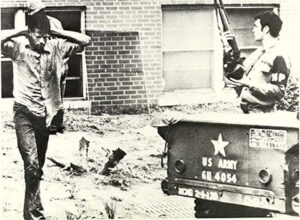
In May 1969, more than 70 students joined a picket line protesting segregation and also the denial of a Black high schooler to run for student body president. Greensboro police and the National Guard responded to the demonstrations by raiding the campus and opening fire on the students. As a result, sophomore Willie Grimes was killed.
Jackson State University
Photo: Jackson State University In May 1970, students protested the U.S. invasion of Cambodia during the Vietnam War as well as the racist taunts from white motorists who would speed viciously through campus and at one time, hitting a student. In response, Mississippi Highway Patrol officers and Jackson police arrived on campus with full riot gear and opened fire after a student threw a bottle at them. Junior Phillip Gibbs and high schooler James Earl Green were killed.
Howard University
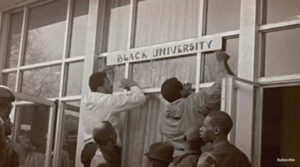
In 1968, more than 9,000 held a four-day protest at Douglass Hall demanding the resignation of President James Nabrit, as well as the exoneration of a group of students who were arrested in a previous protest as well as more Black-focused academic courses. Nabrit ultimately made plans to retire and the students received a seminar to discuss new curriculum.
Woolworth Lunch Counter Sit-In

This particular protest resisting segregation laws began in February of 1960, when a group of North Carolina A&T students sat at a lunch counter in Woolworth reserved for white customers. The students were asked to leave but refused and remained seated until the restaurant closed. The next day, more students arrived and the sit-ins continued for the rest of the month until the mayor agreed to reach a resolution with them. This was only the beginning of the wildfire that would spread across the south, where thousands of college students organized sit-ins to protest segregation and eventually formed the Student Nonviolent Coordinating Committee (SNCC).
Freedom Rides

In May of 1961, the students with the Congress of Racial Equality (CORE) organized the Freedom Rides in which student activists challenged segregation on buses by traveling on them from Washington D.C. to the South. Some freedom riders were met with angry white mobs, bands of police or violent Ku Klux Klan members given legal permission to attack. The rides continued until November, when segregation on interstate buses was made illegal.
Southern Negro Youth Congress
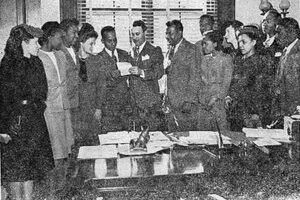
Students from nearly every HBCU in the nation gathered in Richmond, Va in February 1937 to implement strategies on how to support Black Americans in their jobs, voting registration and overall safety from racial violence. Over their 12-year run, they led an anti-lynching campaign, educated Black folks on their rights, organized demonstrations and helped workers fight job discrimination — making their activism visible to government agencies.
Spelman College

In the spring of 1976, Spelman students and faculty protested the fact the school never hired a Black woman as president. The protest resulted in 14 college trustees being locked in a room for 26 hours until they agreed to meet the demands for hiring a Black woman president. Hundreds of students camped out in the hallways outside the room awaiting the decision. Even after the faculty agreed to the terms, it wasn’t until 1987 that Spelman received their first Black woman president, Dr. Johnetta B. Cole.
Atlanta University Center

Students from Clark Atlanta University, Morehouse College, Spelman College and the Morehouse School of Medicine signed an agreement to become to AUC to support the nationwide movement of HBCU students leading peaceful protests for racial equality. Across downtown Atlanta, students held a series of sit-ins and marches, the majority of which ended in arrests. Students would then refuse bail and crowd the jails. With Dr. Martin Luther King’s help, the movement gained even more attention toward the demand of desegregation.
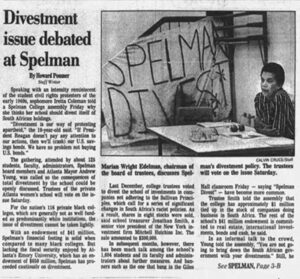
Anti-Apartheid Movement
The college launched what would become a seven-year protest in 1978 against the school’s investment in South Africa during the anti-apartheid movement. By 1986, the school’s board was moved to divest. The year before this, Morehouse joined the movement inviting the family members of notable civil rights leaders to urge students to get involved.
Tuskegee Uprising

In April of 1968, a group of 300 students held members of the board of trustees hostage inside a campus building after their demands of financial aid for athletes, the ceasing of ROTC during the Vietnam War and implementation of more Black-based curriculum were ignored. The campus was closed and student were forced to apply to the school to be readmitted. However, administrators eventually agreed to negotiate and laid the groundwork for a Black studies curriculum that students at other schools would also fight for.
Tougaloo Nine
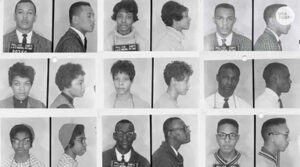
Nine students from Tougaloo College in Jackson, Miss. staged a “read-in” at a whites-only library in March of 1961. Police arrested them when they refused to move across the street to the “colored” library and each were charged with “breach of the peace. An angry white mob swelled outside as they were escorted out. Each were convicted and ordered to pay a fine of $100.


